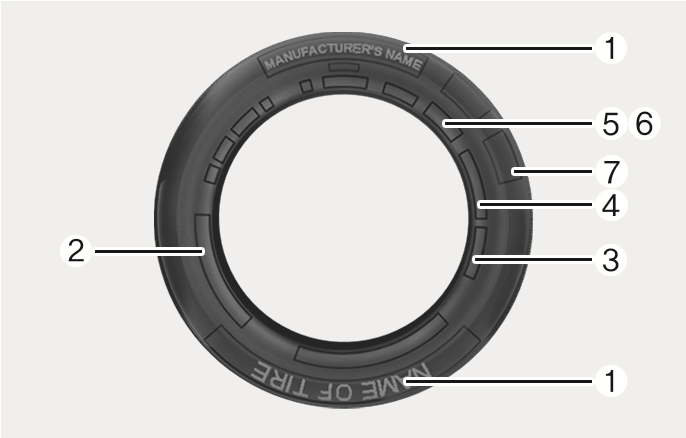Tyre sidewall labelling
This information identifies and describes the fundamental characteristics of the tyre and also provides the tyre identification number (TIN) for safety standard certification. The TIN can be used to identify the tyre in case of a recall.

2C_TireSideWallLabelling
Manufacturer or brand name is shown.
A tyre’s sidewall is marked with a tyre size designation. You will need this information when selecting replacement tyres for your car. The following explains what the letters and numbers in the tyre size designation mean.
Example tyre size designation:
(These numbers are provided as an example only; your tyre size designator could vary depending on your vehicle.)
215/60 R17 98W
215: Tyre width in millimetres.
60: Aspect ratio. The tyre’s section height as a percentage of its width.
R: Tyre construction code (Radial).
17: Rim diameter in inches.
98: Load Index, a numerical code associated with the maximum load the tyre can carry.
W: Speed Rating Symbol. See the speed rating chart in this section for additional information.
Wheel size designation
Wheels are also marked with important information that you need if you ever have to replace one. The following explains what the letters and numbers in the wheel size designation mean.
Example wheel size designation:
7.5J X 19
7.5: Rim width in inches.
J: Rim contour designation.
19: Rim diameter in inches.
Tyre speed ratings
The chart below lists many of the different speed ratings currently being used for passenger vehicle tyres. The speed rating is part of the tyre size designation on the sidewall of the tyre. This symbol corresponds to that tyre’s designed maximum safe operating speed.
|
Speed Rating Symbol |
Maximum Speed |
|
S |
180 km/h |
|
T |
190 km/h |
|
H |
210 km/h |
|
V |
240 km/h |
|
W |
270 km/h |
|
Y |
300 km/h |
Any tyres that are over six years old, based on the manufacturing date, (including the spare tyre) should be replaced by new ones. You can find the manufacturing date on the tyre sidewall (possibly on the inside of the wheel), displaying the DOT Code. The DOT Code is a series of numbers on a tyre consisting of numbers along with English letters. The manufacturing date is designated by the last four digits (characters) of the DOT code.
DOT: XXXX XXXX OOOO
The front part of the DOT shows a plant code number, tyre size and tread pattern and the last four numbers indicate week and year manufactured.
For example:
DOT XXXX XXXX 1523 represents that the tyre was produced in the 15th week of 2023.
The number of layers or plies of rubber-coated fabric in the tyre. Tyre manufacturers also must indicate the materials in the tyre, which include steel, nylon, polyester, and others. The letter “R” means radial ply construction; the letter “D” means diagonal or bias ply construction; and the letter “B” means restrained-bias ply construction.
This number is the greatest amount of air pressure that should be put in the tyre. Do not exceed the maximum permissible inflation pressure. Refer to the Tyre and Loading Information label for recommended inflation pressure.
This number indicates the maximum load in kilograms that can be carried by the tyre. When replacing the tyres on the vehicle, always use a tyre that has the same load rating as the factory installed tyre.
Quality grades can be found where applicable on the tyre sidewall between tread shoulder and maximum section width.
For example:
TREADWEAR 200
TRACTION AA
TEMPERATURE A
Tread wear
The tread wear grade is a comparative rating based on the wear rate of the tyre when tested under controlled conditions on a specified government test course. For example, a tyre graded 150 would wear one-and-a-half times (1½) as well on the government course as a tyre graded 100.
The relative performance of tyres depends upon the actual conditions of their use, however, and may depart significantly from the norm due to variations in driving habits, service practices and differences in road characteristics and climate.
These grades are molded on the sidewalls of passenger vehicle tyres. The tyres available as standard or optional equipment on your vehicle may vary with respect to grade.
Traction - AA, A, B & C
The traction grades, from highest to lowest, are AA, A, B and C. Those grades represent the tyre’s ability to stop on wet pavement as measured under controlled conditions on specified government test surfaces of asphalt and concrete. A tyre marked C may have poor traction performance.
The traction grade assigned to this tyre is based on straight ahead braking traction tests, and does not include acceleration, cornering, hydroplaning, or peak traction characteristics.
Temperature - A, B & C
The temperature grades are A (the highest), B and C representing the tyre’s resistance to the generation of heat and its ability to dissipate heat when tested under controlled conditions on a specified indoor laboratory test wheel.
Sustained high temperature can cause the material of the tyre to degenerate and reduce tyre life, and excessive temperature can lead to sudden tyre failure. Grades B and A represent higher levels of performance on the laboratory test wheel than the minimum required by law.
The temperature grade for this tyre is established for a tyre that is properly inflated and not overloaded. Excessive speed, under-inflation, over-inflation, or excessive loading, either separately or in combination, can cause heat build-up and possible sudden tyre failure. This may cause loss of vehicle control resulting in an accident.